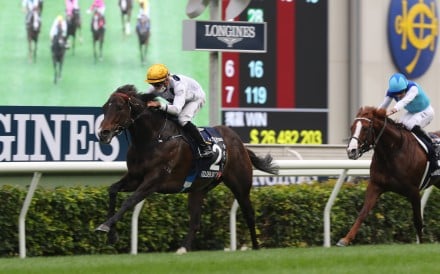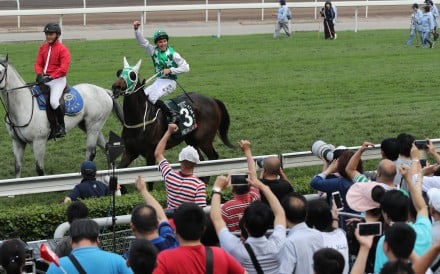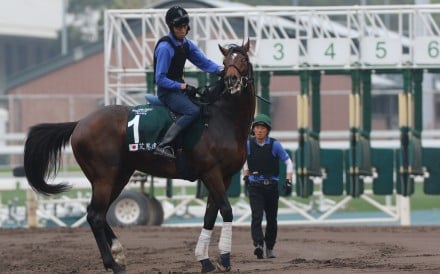Jim Howard is fond of carrying in his shirt pocket a photocopied sheet with a short passage: “Do not seek praise. Seek criticism.”
And as the man in charge of maintaining Sha Tin's dirt tracks, he picked the right job for a test of his adopted motto.
“The day that no one is bitching about you, which might not be very often, is the day you know you've done a good job,” Howard said last week.
It wasn't asked for, but consider this blog praise for one of Sha Tin's unsung heroes.
The 68-year-old American has one of the most difficult, demanding and thankless tasks in racing. It's also one of the most important.
Even though Howard is unknown to most outside the small sphere of Sha Tin's trainers and the track maintenance team, he is one of the Jockey Club's most indispensable employees.

Blessed with a tireless work ethic, Howard lives on course, is on call 24 hours a day, seven days a week, with a schedule dictated by weather conditions.
He has also designed and in some cases built much of the equipment he uses to tend to the so-called “all-weather track” and the smaller jogging track inside of that.
What many don't know is that Howard has earned his chops as a horseman too, as one of the assistant trainers to legendary American D. Wayne Lukas during the stable's heyday from the mid-1980s to early-1990s.
“I had my assistant trainer licence but I was more of a all-rounder and troubleshooter than being heavily involved in the training of horses,” Howard said, humbly. “He had 300 horses at that time and the boss could tell you about every one of them in an instant."
If Howard seems unmoved by criticism of his track, working under the famously demanding handler probably conditioned his resolve.
"Yeah, he was tough, but fair," he recalled. "He used to say you only have to work half the time … 12 hours per day."
At the tail-end of Howard's 15-year tenure with Lukas, he took on maintenance of the dirt track at the trainer's yearling preparation facility in San Diego. From there he moved to the company that installed Sha Tin's dirt track in 1996 – and has been here ever since.

Trainer Tony Millard calls Howard “the best in the world at what he does” and that's coming from a man who, from personal experience, is much more adept at delivering a scathing assessment than a glowing review.
“Ultimately you've got to respect Jim – he is a professional and he makes a lot of good calls. A lot of people have an opinion on what he does and he listens to criticism but he does what he thinks is right," Millard says.
"He is right more times than he isn't and if he says that track is right, I'm prepared to go on it.”
The South African trainer joked that the day Howard can't climb into his machine, "the club needs to buy some type of lift or hoist to get him into the cab”.
A few common misconceptions about the all-weather track, the first which has already been dealt with in this space on multiple occasions: it's not an “all-weather track” in the traditional sense and there's nothing artificial about it. Just sand, clay and some “organic content” in the form of pine bark.
The second misconception is that dirt is somehow not as “high maintenance” as turf – the man-hours Howard and his team put in pulling various graders, rakes and blades around the 1,600m circuit every day make a mockery of that idea.
There's an element of science to it as well, with laminated print-outs hanging in Howard's cab with recent readings of silt, clay and sand content – all broken down into tenths of a per cent and specific to the time of the year to take into account moisture content and temperature.
A third common misconception is that a dirt surface is harder than the turf. Jockey Brett Prebble says that when the “AWT” has been freshly harrowed and tilled, with fresh supplies: “It's the best dirt track in the world. Horses just float on it. Jim does an amazing job, that's his baby.”

The ironic part of the all-weather name is that Howard has to be on a constant look-out for rain, lest his baby turns into an unusable quagmire.
At Saturday's meeting Howard and his 10-man team had to spring into action at short notice as the circuit changed from “good” to “wet fast” before a rapidly approaching downpour, his workers managing to seal the track before the mid-meeting deluge arrived.
As much as a wet track on raceday isn't desirable, losing the two training tracks – where all 1,200 or so of Sha Tin's equine residents train – is simply inconceivable.
That's a lot of pressure, and that's not taking into account having a bunch of angry trainers breathing down your neck.
“The thing I like about these guys, the trainers, is if they don't think it's right they'll blast you,” said Howard, who recently agreed to a one-year extension.
“It's not an easy job, or other people would want to do it, but I never get tired of it. I love teaching and I love challenges.”





















